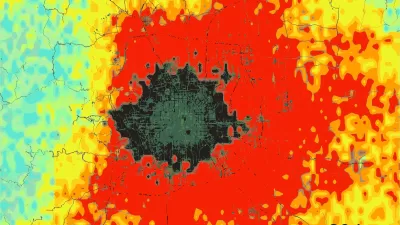Policies that encourage density as a way to reduce carbon emissions won't be able to play a significant role in reducing carbon emissions in time to counteract global warming, according to a new report from the National Academy of Sciences.
The change brought on by rapid densification, urbanization and abandonment of sprawl development patterns by 2050 would not be enough to counteract climate change brought on by carbon dioxide emissions, according to the report.
"Urban planners hoping to help mitigate CO2 emissions by increasing housing density would do better to focus on fuel-efficiency improvements to vehicles, investments in renewable energy, and cap and trade legislation now being voted on in Congress, according to the study, released Tuesday. It concludes that increasing population density in metropolitan areas would yield insignificant CO2 reductions.
Even if 75 percent of all new and replacement housing in America were built at twice the density of current new developments, and those living in the newly constructed housing drove 25 percent less as a result, CO2 emissions from personal travel would decline nationwide by only 8 to 11 percent by 2050, according to the study. If just 25 percent of housing units were developed at such densities and residents drove only 12 percent less as a result, CO2 emissions would be reduced by less than 2 percent by 2050."
FULL STORY: Forget Curbing Suburban Sprawl

Depopulation Patterns Get Weird
A recent ranking of “declining” cities heavily features some of the most expensive cities in the country — including New York City and a half-dozen in the San Francisco Bay Area.

California Exodus: Population Drops Below 39 Million
Never mind the 40 million that demographers predicted the Golden State would reach by 2018. The state's population dipped below 39 million to 38.965 million last July, according to Census data released in March, the lowest since 2015.

Chicago to Turn High-Rise Offices into Housing
Four commercial buildings in the Chicago Loop have been approved for redevelopment into housing in a bid to revitalize the city’s downtown post-pandemic.

DC Bikeshare System Breaks Ridership Record
Capital Bikeshare users took over 20,000 rides on one day in March.

EV Infrastructure Booming in Suburbs, Cities Lag Behind
A lack of access to charging infrastructure is holding back EV adoption in many US cities.

Seattle Road Safety Advocates Say Transportation Levy Perpetuates Car-Centric Status Quo
Critics of a proposed $1.3 billion transportation levy say the package isn’t enough to keep up with inflation and rising costs and fails to support a shift away from car-oriented infrastructure.
Barrett Planning Group LLC
City of Cleburne
KTUA Planning and Landscape Architecture
HUD's Office of Policy Development and Research
Mpact Transit + Community
HUD's Office of Policy Development and Research
City of Universal City TX
ULI Northwest Arkansas
City of Laramie, Wyoming
Urban Design for Planners 1: Software Tools
This six-course series explores essential urban design concepts using open source software and equips planners with the tools they need to participate fully in the urban design process.
Planning for Universal Design
Learn the tools for implementing Universal Design in planning regulations.






















